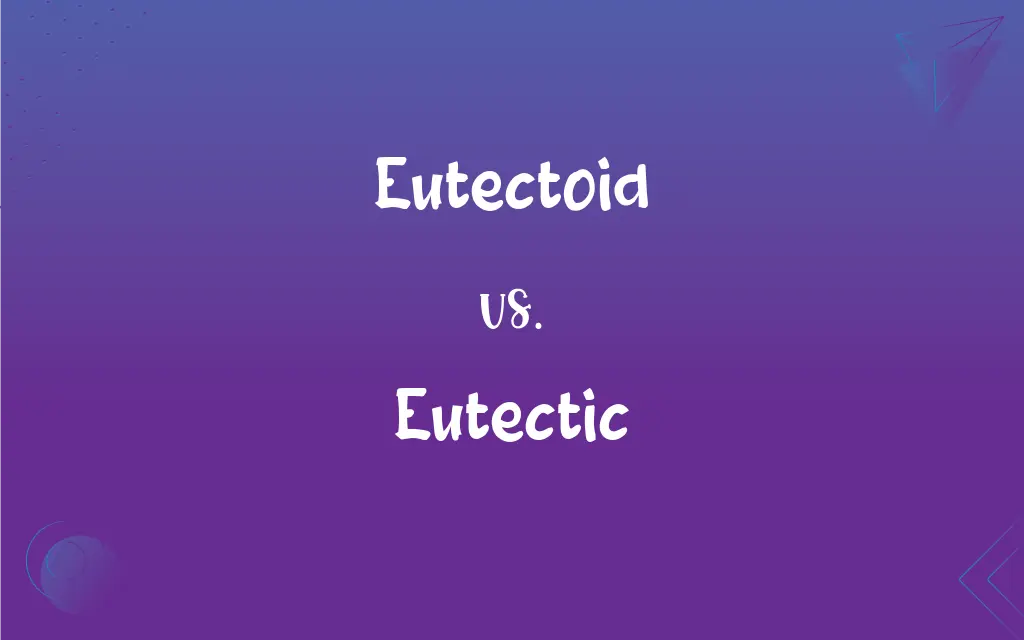Eutectoid vs. Eutectic: What's the Difference?
By Aimie Carlson & Harlon Moss || Updated on May 20, 2024
Eutectoid refers to a phase transformation in solid-state alloys, while eutectic describes a mixture of substances that melts at a lower temperature than any of its components.

Key Differences
Eutectoid transformations occur in solid-state alloys, where a single solid phase transforms into two different solid phases at a specific temperature and composition. Eutectic mixtures involve the melting process, where two or more components form a liquid at a specific composition and temperature lower than the melting points of the individual components.
While eutectoid transformations are significant in understanding the microstructure and properties of alloys, eutectic mixtures are crucial in applications requiring precise melting points, such as soldering and casting. Eutectoid reactions involve solid-state diffusion, whereas eutectic reactions involve liquid phase formation.
Eutectoid compositions are found in phase diagrams of alloys like steel, where they indicate the transformation points between different solid phases. Eutectic compositions are also depicted in phase diagrams but are associated with the liquid-to-solid transformation.
Eutectoid reactions generally occur at lower temperatures compared to eutectic reactions, reflecting the different nature of the solid-state versus liquid-state transformations. The eutectoid point is a key concept in metallurgical processes like heat treatment, while the eutectic point is crucial in materials science for developing alloys with specific melting characteristics.
Comparison Chart
Definition
Solid-state phase transformation
Liquid-state mixture with lower melting point
ADVERTISEMENT
Example
Austenite to pearlite in steel
Lead-tin solder mixture
Temperature
Specific temperature in solid-state
Specific melting temperature lower than components
Process
Solid phase to two different solid phases
Solid components to liquid mixture
Application
Metallurgy, heat treatment of steels
Soldering, casting
Eutectoid and Eutectic Definitions
Eutectoid
A solid-state transformation where one solid phase converts into two different solid phases.
The eutectoid transformation in steel occurs at about 727°C.
ADVERTISEMENT
Eutectic
Forms a liquid phase at a specific composition and temperature.
Eutectic alloys are designed to have precise melting points.
Eutectoid
Key concept in understanding alloy properties and behavior.
Engineers study eutectoid reactions to enhance the mechanical properties of metals.
Eutectic
A mixture of substances that melts at a lower temperature than any of its components.
The eutectic point of the lead-tin alloy is ideal for soldering.
Eutectoid
Found in phase diagrams of alloys like iron-carbon systems.
The eutectoid point on the iron-carbon phase diagram indicates the formation of pearlite.
Eutectic
Used in applications requiring controlled melting temperatures.
Eutectic salts are used in thermal energy storage systems.
Eutectoid
Occurs at a specific composition and temperature in alloys.
The eutectoid composition is crucial for predicting microstructural changes in steel.
Eutectic
Shown in phase diagrams with a specific eutectic composition.
The eutectic mixture appears at the lowest point in the phase diagram.
Eutectoid
Involves diffusion of atoms in the solid state.
Eutectoid reactions require precise temperature control during heat treatment.
Eutectic
Involves the melting and solidification of components.
Eutectic reactions are important in casting and joining processes.
Eutectoid
Describing the phase-change reaction of an alloy in which, on cooling, a single solid phase transforms into two other solid phases.
Eutectic
Of, relating to, or formed at the lowest possible temperature of solidification for any mixture of specified constituents. Used especially of an alloy whose melting point is lower than that of any other alloy composed of the same constituents in different proportions.
Eutectoid
Of or relating to a eutectic mixture or alloy.
Eutectic
Exhibiting the constitution or properties of such a solid.
Eutectoid
A eutectic mixture, solution, or alloy.
Eutectic
A eutectic mixture, solution, or alloy.
Eutectoid
An alloy of a composition that undergoes the eutectoid transformation.
Eutectic
The eutectic temperature.
Eutectic
Describing the chemical composition or temperature of a mixture of substances that gives the lowest temperature at which the mixture becomes fully molten. A further requirement is that that temperature is lower than the melting point of any of the pure component substances.
Eutectic
(chemistry) Describing the thermodynamic equilibrium conditions where a liquid coexists with two solid phases.
For a mixture with two components at a fixed pressure, the eutectic reaction can only happen at a fixed chemical composition and temperature, called the eutectic point.
Eutectic
A material that has the composition of a eutectic mixture or eutectic alloy
Eutectic
The temperature of the eutectic point
Eutectic
Of maximum fusibility; - said of an alloy or mixture which has the lowest melting point which it is possible to obtain by the combination of the given components.
Eutectic
A mixture of substances having a composition providing the minimum melting point ofr mixtures of those substances. Called also a eutectic mixture.
Eutectic
A mixture of substances having a minimum melting point
FAQs
Can eutectoid reactions happen in liquids?
No, eutectoid reactions only occur in solid-state materials.
What does eutectic mean in materials science?
It refers to a mixture that melts at a lower temperature than any of its individual components.
What is a eutectoid transformation?
It is a solid-state phase change where one solid phase transforms into two distinct solid phases.
How are eutectic points depicted in phase diagrams?
As the lowest melting point of a mixture, at the intersection of liquid and solid phases.
Where does eutectoid transformation occur?
It occurs in alloys, such as the transformation of austenite to pearlite in steel.
Do eutectoid transformations require heat?
Yes, they occur at specific temperatures during heating or cooling processes.
What industries use eutectoid transformations?
Primarily the metallurgy and materials engineering industries.
What happens at a eutectic temperature?
The components melt together at a specific lower temperature to form a liquid.
What is an example of a eutectic mixture?
A lead-tin alloy used in soldering.
Why are eutectic alloys important?
They have precise melting points, useful in applications like soldering and casting.
Can eutectoid reactions change alloy properties?
Yes, they significantly affect mechanical properties.
How do eutectic mixtures benefit casting processes?
They provide precise melting points for better control.
Is a eutectoid composition always the same?
No, it varies with different alloy systems.
Can eutectic alloys be used in electronics?
Yes, especially in soldering electronic components.
Do eutectic reactions involve solid-state diffusion?
No, they involve melting and solidification.
What is a common use of eutectic salts?
In thermal energy storage systems.
Why is the eutectic point significant?
It indicates the precise melting temperature and composition for optimal alloy properties.
How do engineers use eutectoid information?
To optimize heat treatment processes and improve alloy performance.
Are eutectoid reactions fast or slow?
They can vary but often require controlled cooling rates.
What is pearlite?
A microstructure formed during the eutectoid transformation in steel.
About Author
Written by
Aimie CarlsonAimie Carlson, holding a master's degree in English literature, is a fervent English language enthusiast. She lends her writing talents to Difference Wiki, a prominent website that specializes in comparisons, offering readers insightful analyses that both captivate and inform.
Co-written by
Harlon MossHarlon is a seasoned quality moderator and accomplished content writer for Difference Wiki. An alumnus of the prestigious University of California, he earned his degree in Computer Science. Leveraging his academic background, Harlon brings a meticulous and informed perspective to his work, ensuring content accuracy and excellence.































































